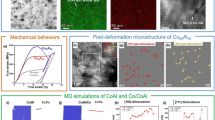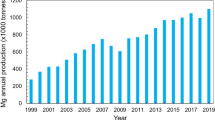The process of single crystals plastic deformation at the atomic level according to the previously proposed discrete model is described. The single crystals are considered as a two-phase structure, consisting of surface layers and inner regions of a perfect crystalline lattice. The effect of surface on the strength of single crystals of perfect structure is analyzed. As the proportion of the surface layer in the total volume of thick single crystals is small, this influence is insignificant. Increase of the number of defects after plastic deformation significantly increases the crystal strength. On the other hand, because of the small size of whisker crystals, the surface is of significant influence. It is concluded that the mechanisms of plastic deformation at the atomic level are the same for both thin and thick crystals, despite the differences in their stress-strain diagrams.




Similar content being viewed by others
References
Whisker Crystals: https://web.posibnyky.vntu.edu.ua/fmbt/suvak_novi_materiali_kompoziti/1-7.html
G. V. Berezhnova, Whisker Crystals [in Russian], Nauka, Kyiv (1969).
E. M. Nadgornyi, “Properties of whisker crystals,” Uspekhi Fiz. Nauk, 77, No. 2, 227 (1962).
L. Yu. Kozak, “New discrete model of plastic deformation of solid bodies,” Mater. Sci., 55, No. 4, 461–468 (2020); DOI: https://doi.org/10.1007/s11003-020-00326-z.
L. Yu. Kozak, Alternative Concept of Solids’ Plasticity [in Ukrainian], Nation. Techn. Univ. Oil and Gas, Ivano-Frankivsk (2020).
V. I. Likhtman, P. A. Rebinder, and H. V. Karpenko, The Influence of Surface-Active Environment on Deformation Processes of Metals [in Russian], Publ. House of the USSR Acad. Sci., Moscow (1954).
Ya. I. Frenkel, Introduction into Theory of Metals [in Russian], Nauka, Leningrad (1972).
E. Shmidt, and V. Boas, Plasticity of Crystals, Especially of Metal Ones [in Russian], Publ. House of Foreign Lit., Moscow-Leningrad (1938).
W. H. Bragg, and W. L. Bragg, Crystal State [in Russian], Nauch. Tech. Publ. House of the USSR, Moscow (1938).
D. Gough Hanson, and S. J. Wright, “The behavior of single crystals of aluminum under static and repeated stresses,” Philos. Transact. Royal Soc., 226, 1–30 (1927).
F. R. N. Nabarro, Z. S. Bazinski, and D. B. Holt, Plasticity of Pure single Crystals [in Russian], Metallurgiya, Moscow (1967).
M. V. Klassen-Nekliudova, and T. A. Kontorova, “Nature of inercrystalline layers,” Uspekhi Fiz. Nauk, 22, No. 3, 143–151 (1939).
V. I. Arkharov, Yu. G. Skripka, and E. S. Markhasin, “The importance of the mechanism of forming interatomic bonds in alloys for their strength and plastic properties,” Sov. Mater. Sci., 14, No. 2, 151–154 (1978); DOI: https://doi.org/10.1007/BF00720574.
L. Y. Kozak, “Investigation of the instability of crystal lattices by using discrete models,” Mater. Sci., 53, No. 3, 424–430 (2017); DOI: https://doi.org/10.1007/s11003-017-0091-x.
L. Y. Kozak, Plasticity of Metals and Instability of Crystal Lattice [in Ukrainian], Fakel Publ. House, Ivano-Frankivsk (2004).
S. Z. Bokstein, S. T. Kishkin, M. P. Nazarova, and I. L. Swetlow, Features of Hardening of Metallic and Non-Metallic Whisker Single Crystals [in Russian], Naukova Dumka, Kyiv (1972).
A. M. Belikov, Plastic Deformation of Whisker Crystals [in Russian], Voronezh Univ. Publ. House, Voronezh (1991).
T. Ogata, K. Ishikawa, K. Nagai, and T. Yuri, “Time-dependent deformation of austenitic stainless steels at cryogenic temperatures,” Cryogenics, 26, No. 6, 365–369 (1986); DOI: https://doi.org/10.1016/0011-2275(86)90067-6.
S. N. Zhurkov, “Kinetic concept of solids’ strength,” Vestnik Acad. Nauk USSR, No. 3, 46–52 (1968).
U. F. Kocks, Kinetics of Nonuniform Deformation, Progress in Materials Science, Chalmers Anniversary Volume, Pergamon Press, Oxford, 19, 185–241 (1981).
G. A. Malygin, “Low-temperature instability of plastic deformation of metals,” Physics of Metals and Metallography, 40, No. 1, 21–28 (1975).
B. J. Brindley, and P. J. Worthington, “Yield-point phenomena in substitutional alloys,” Metallurg. Rev., 15, Is. 1, 101–114 (1970); DOI: https://doi.org/10.1179/mtlr.1970.15.1.101.
V. P. Alekhin, Physics of Strength and Plasticity of Surface Layers of Materials [in Russian], Nauka, Moscow (1983).
A. F. Ioffe, Physics of Crystalls [in Russian], Gosizdat, Leningrad (1929).
Author information
Authors and Affiliations
Corresponding author
Additional information
Translated from Fizyko-Khimichna Mekhanika Materialiv, Vol. 58, No. 4, pp. 37–44, July–August, 2022
Rights and permissions
Springer Nature or its licensor (e.g. a society or other partner) holds exclusive rights to this article under a publishing agreement with the author(s) or other rightsholder(s); author self-archiving of the accepted manuscript version of this article is solely governed by the terms of such publishing agreement and applicable law.
About this article
Cite this article
Kozak, L.Y. Specific Features of Whisker Crystals Plastic Deformation. Mater Sci 58, 466–473 (2023). https://doi.org/10.1007/s11003-023-00686-2
Received:
Published:
Issue Date:
DOI: https://doi.org/10.1007/s11003-023-00686-2




